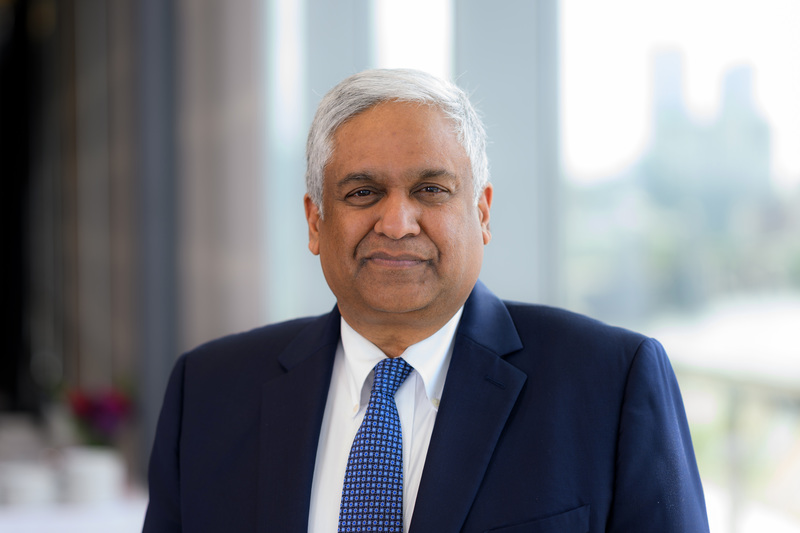Meet MIT’s new provost, Anantha Chandrakasan
Chandrakasan: “Whatever it means to enable impact, that’s my single goal”
On Oct. 15, The Tech interviewed MIT Provost Anantha Chandrakasan, discussing his first few months as provost. He stressed the importance of collaboration, community, and diversity in research, highlighting his aim to support faculty and encourage students to make a global impact. Chandrakasan also reflected on MIT’s financial challenges and provided insights on how AI will shape the future of education.
Amidst new challenges for higher education in the U.S., Chandrakasan is focused on solving the Institute’s most complex problems. “Whatever it means to enable impact, that’s my single goal,” he said.
Transitioning from Dean to Provost
Chandrakasan has been a faculty member at MIT since 1994. He served as the head of the Department of Electrical Engineering and Computer Science from 2011 to 2017. In July 2025, Chandrakasan succeeded Cynthia Barnhart SM ’86 PhD ’88, having previously served as the Dean of Engineering and as the Institute’s first Chief Innovation and Strategy Officer (CISO).
As Dean, Chandrakasan oversaw the hiring and promotion of faculty members, which allowed him to “see the diversity of research” within the School and gave him a “broad appreciation for all the types of scholarship.” During the pandemic, former provost Martin Schmidt PhD ’88 appointed Chandrakasan as the lead dean, allowing Chandrakasan to collaborate with the deans of other MIT schools and colleges. Now that he is provost, it is the MIT community at large that helps him “in formulating important decisions.”
Chandrakasan said it was “a huge honor” to be appointed as the provost. “MIT has done so much for me,” he said. In regard to the transition from dean to provost, Chandrakasan described it as “seamless,” as he is able to “do many things in parallel” and make difficult decisions “in a timely manner.” He joked that the biggest adjustment was getting used to the large office space and longer working hours.
The role of a “facilitator”
As provost, Chandrakasan said he is here to help the entire MIT community. In his eyes, his role is to be a “facilitator,” someone who can “bring in resources” to help faculty and students “thrive in research, education and entrepreneurship” so they can have an impact not only in the U.S., but also in the world.
As part of his efforts to support students, Chandrakasan has been working with the Chancellor’s office to hold the first-ever UROP mixer, which connects students with research opportunities. He acknowledges that the initiative will “start small,” but he expects it to soon resemble the Institute’s Fall Career Fair.
The role of provost also comes with unexpected challenges. “We’re problem-solving from day one,” said Chandrakasan, stressing his aim to support faculty and students as they navigate changing funding landscapes and new governmental decisions. He aims to “do as much as possible” to bring in resources and drive the strategic priorities set by President Sally Kornbluth. These initiatives include The Climate Project at MIT, the MIT Human Insight Collaborative (MITHIC), and the MIT Generative AI Impact Consortium (MGAIC).
Chandrakasan added that these platforms and initiatives are a great way for the Institute to receive and distribute funding “through a competitive process.” He said that he expects this funding to trickle down to students, researchers and staff working on these projects.
Industry and innovation
When Chandrakasan was announced as the new provost, his colleagues praised his commitment to driving innovation and fostering connections between research institutions and the private sector. As the inaugural CISO, Chandrakasan founded industry initiatives such as the MIT-IBM Watson AI Lab and the MIT-Takeda Program. He will continue to engage in these initiatives, as he now oversees the Office of Innovation and Strategy.
One new initiative that Chandrakasan became involved in is the MIT-MGB Seed Program, a collaboration between the Institute and Mass General Brigham with support from Analog Devices, Inc. MIT-MGB will fund joint research projects that advance technology and clinical research in human health with the goal of developing next-generation therapies, diagnostics, and digital tools.
Chandrakasan said that this model of collaborating with hospitals and companies will “unlock access to incredible health data” and “allow us to create cures for rare diseases.” Although he recognizes that there is brilliant research happening in these fields, he believes that faster progress must be made to make the most impact. “My goal is to say, ‘How are we not just going to do the basic research? How are we going to accelerate this out to commercial?’” Chandrakasan said.
How AI will reshape research and education
When asked about the use of artificial intelligence (AI) models in higher education, Chandrakasan stated, “Every field is going to be impacted.” The provost expects AI to transform research and education, but admitted it’s too soon to know exactly how. According to him, more information needs to be collected to determine how MIT can best leverage AI in education and research.
Despite these open-ended questions, Chandrakasan believes that some applications of AI are improving education; for example, large language models (LLMs) can help students learn by acting as “personalized tutors.” He also highlighted recent initiatives such as Universal AI, a series of modules that teach the underlying theories, concepts, and technologies of artificial intelligence.
“Sloan has already incorporated [AI tutors] into some of their classes, and that’s the baseline,” Chandrakasan said, pointing out that this approach could extend to personalized support for UROPs or research initiatives, particularly in cases such as curating information.
Chandrakasan added that he has seen interesting work in the usage of generative AI in classes or software design. “These experiments are going to be very important and insightful as we lay out a full road map of technologies,” he said. Initiatives such as MGAIC are expected to support this research. So far, MGAIC has granted funding to 60 projects that aim to explore high impact uses of generative AI models.
In addition to academia, Chandrakasan would also like to leverage AI in other fields. “The vision of the college is to create computational bilinguals,” he said.
Thoughts on finances
In a letter to the MIT community sent last month, President Sally Kornbluth said the university faces “significant new financial pressures” that include an increased tax on its endowment, which will rise from 1.4% to 8% in fiscal year 2027.
When asked about these challenges, Chandrakan admitted there is a “lot of activity happening,” pointing out that the increased endowment tax imposed on MIT amounts to $300 million per year. “We greatly rely on the endowment payout for us to operate the Institute, and that’s a large amount of recurring costs that we have to absorb,” he said.
To address these challenges, Chandrakasan and Executive Vice President and Treasurer (EVPT) Glen Shor have formed a Financial Scenarios Working Group to hear from experts and faculty. Chandrakasan emphasized the importance of considering various factors, and added that the university is currently doing “as much as [they] can, centrally, to minimize the impact on the academic programming.”
Despite the future budget reductions, Chandrakasan wants to prioritize and preserve the undergraduate financial aid program and graduate student fellowships program. In return, however, he must consider cutting funding from other areas, which requires fielding input from various student and faculty perspectives, even if the proposed ideas may lead to disagreement. “Taking money out of the endowment itself to solve [it] doesn’t help,” Chandrakasan said. “Because eventually, the endowment will go to zero.”
Hearing students’ voices
As Chandrakasan settles into his new role, he told The Tech that his main priority is to help the community, and he is very open to hearing the voice of the student body. “That’s why I took this job,” he said.
“I greatly benefited from MIT and what it did for me,” he added. “Let me be very clear: I’m here for the students. We’re here to create the next generation of leaders.”





